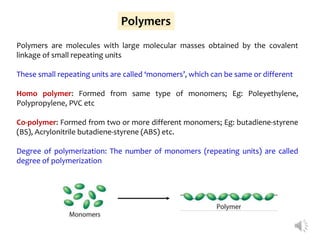
Module 4-Polymers-1.pptx
- 1. Polymers Polymers are molecules with large molecular masses obtained by the covalent linkage of small repeating units These small repeating units are called ‘monomers’, which can be same or different Homo polymer: Formed from same type of monomers; Eg: Poleyethylene, Polypropylene, PVC etc Co-polymer: Formed from two or more different monomers; Eg: butadiene-styrene (BS), Acrylonitrile butadiene-styrene (ABS) etc. Degree of polymerization: The number of monomers (repeating units) are called degree of polymerization
- 2. Classification based on Types of polymerization Polymers Addition Polymers Condensation Polymers 1,2-addition 1,4-addition Polyesters -COO- Polyamides -CO-NH- Polycarbonates -O-COO- Polyethers -O-
- 3. Addition Polymers Formed by the combination of simple unsaturated molecules through addition reaction Conversion of C-C π-bonds to strong C-C sigma bond is the driving force for the polymerization Addition polymerisation is brought about by small amount of initiators which will generate free radicals, cations, anions etc which helps to grow the polymer The monomers added to the free radicals or active species and the chain growth takes place. So addition polymerisation is also known as chain growth polymerisation There are two types: 1,2-addition and 1,4-addition
- 4. 1,2-Addition Polymers Each monomer consists of a π bond and it is converted into a sigma bond by joining 1,2 positions of each monomer unit Eg: Polymerisation of ethylene, propene, polyvinyl chloride, styrene etc 1 2
- 5. 1,4-Addition Polymers Each monomer consists of two π bond and new bond is formed at the middle (2,3 positions) by joining 1,4 positions of each monomer unit Eg: Polymerisation of butadiene, isoprene, chloroprene etc 2 3 4 1 When X = H, it is called polybutadiene rubber Rubbers When X = CH3, it is called polyisoprene; cis form is called natural rubber and trans form is known as synthetic rubber (Gutta-percha) When X = Cl, it is called chloroprene rubber or “Neoprene”
- 6. Condensation Polymers Linking together monomer units accompanied by the elimination of simple molecules like water, ammonia, HCl etc. Monomer units are usually different in this case Degree of polymerisation depends on the availability of the reactive groups at the end of growing chain It is also known as “step-growth polymerization” as the process takes place in a step by step manner
- 8. Co-polymers Polymerization of 2 or more different monomeric species together Eg: Acrylonitrile-vinyl chloride, Butadiene-Styrene (BS), Acrylonitrile-Butadiene-Styrene (ABS) 1 2
- 9. Types of co-polymers 1. Random co-polymers During co-polymerization, if a mixture of monomers are allowed to polymerize, random co-polymer will be formed Eg: A mixture of acrylonitrile (A) and vinylchloride (B) is allowed to polymerize the resulting random polymer will be like, -A-A-B-A-B-B-B-A-B-A-A-A-B-B-A-B-A-B- 2. Alternating co-polymers Two types of monomeric units distributed in alternating sequence. Eg: A mixture of Styrene (A) and butadiene (B) is allowed to polymerize the resulting alternate polymer (AB)n will be like, -A-B-A-B-A-B-A-B-A-B-A-B-A-B-
- 10. 3. Block co-polymers This type can be synthesized by partially polymerizing each monomer into a resin or semi polymer. Semipolymer obtained on further combination results Block co-polymers Here the monomers form long blocks -A-A-A-A-A-A-A-A-B-B-B-B-B-B-A-A-A-A-A-A-A 4. Graft co-polymers This is a type of Block co-polymer. Here the semipolymer of one monomer (B) are grafted to the high main polymer chain (A) The arrangement will be represented as -A-A-A-A-A-A-A-A-A-A-A-A-A-A-A-A-A-A-A B B B B B B B B
- 11. Acrylonitrile Butadiene Styrene (ABS) Synthesis: It is a ter polymer (3 diff units), made by polymerising styrene (40-60%) and acrylonitrile (15-35%) in presence of poly butadiene (5-30%). ABS is a long chain of polybutadiene criss-crossed with shorter chains of poly(styrene-co-acrylonitrile). The nitrile groups from neighboring chains, being polar, attract each other and bind the chains together, making ABS stronger than pure polystyrene.
- 12. Properties of ABS 1. The styrene gives the plastic a shiny, impervious surface. The polybutadiene, a rubbery substance, provides toughness even at low temperatures. 2. ABS is an amorphous thermoplastic polymer with glass transition temperature of approximately 105 °C (221 °F) 3. It has the strength and rigidity of acrylonitrile and styrene with an added toughness of poly butadiene 4. It is considered as one of the best due to its hardness, gloss, toughness and electrical insulation properties 5. It is resistant to aqueous acids and alkalies Characteristics 1. Medium strength 2. Tough, Hard and Rigid 3. Good Chemical Resistance 4. Dimensional Stability 5. Creep Resistant 6. Electroplatable 7. Outstanding formability 8. High impact strength 9. High Tensile strength 10. Excellent ductility
- 13. Applications of ABS LEGO building blocks Used for the manufacturing of TV cabin Computer Monitor Body, Keyboard body Mobile Phone Body Kitchen Appliances Musical Instruments Automotive trim components
- 14. Kevlar (Poly-paraphenylene terephthalamide) Synthesis: Kevlar is synthesized in solution from the monomers para-phenylene diamine and tetraphthaloyl chloride in a condensation reaction yielding HCl gas as biproduct The product is a polymeric aromatic amide with alternating benzene rings and amide groups When they are produced the polymer strands are aligned randomly • The high strength of the polymer may be due to the inter-molecular hydrogen bonds form between the carbonyl groups and NH centers. • Additional strength is derived from aromatic stacking interactions between adjacent strands.
- 15. Molecular Structure of Kevlar Dashed lines indicates the H-Bonds Applications 1. Often used in the field of Cryogenics due to its low thermal conductivity and high strength at low temperature 2. Used in aerospace applications due to its high strength to weight ratio 3. Kevlar is well known for the manufacture of personal armor such as combat helmets, ballistic facemasks, ballistic vests, special type of gloves etc 4. Since they are found to have good acoustic properties, they are also used in loudspeaker cones for bass and midrange drive units 5. Used as strength member in fibre optic cables for audio data transmissions